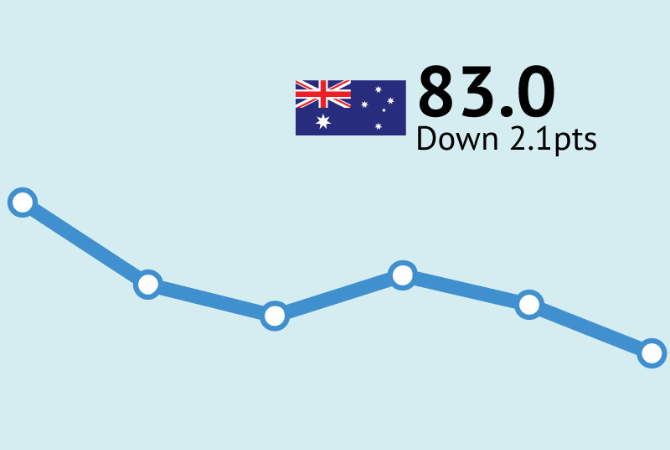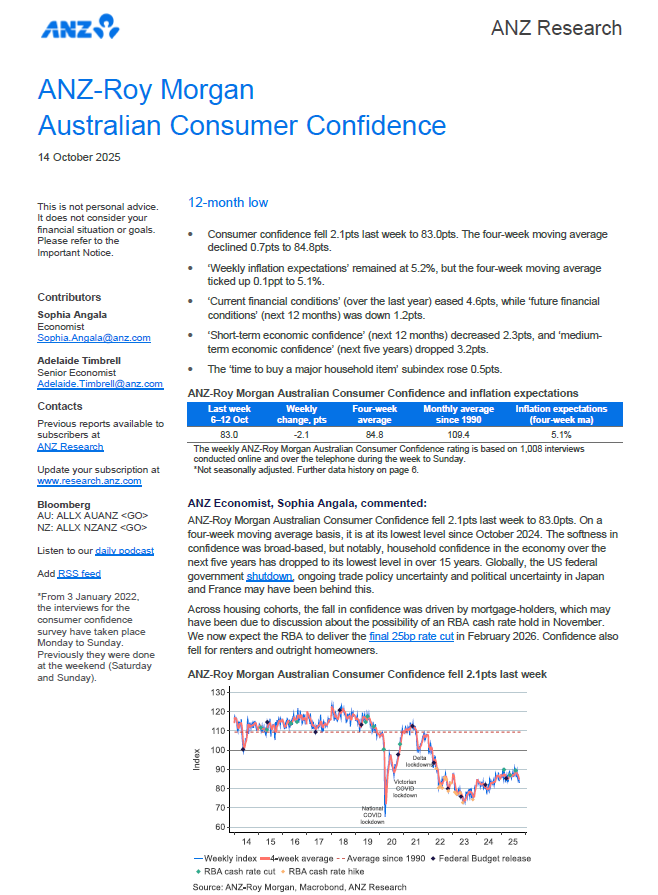ANZ-Roy Morgan Consumer Confidence down 2.1pts to 83.0 – down for a second straight week after RBA leaves rates unchanged

ANZ-Roy Morgan Consumer Confidence dropped 2.1pts to 83.0, now down for a second straight week after the Reserve Bank left interest rates unchanged at 3.6%. Consumer Confidence is now at its lowest for over a year but is virtually unchanged on the same week a year ago, October 7-13, 2024 (83.4), and 3.7pts below the 2025 weekly average of 86.7.
An analysis by State shows mixed results with declines in New South Wales, Victoria and South Australia, only partially offset by small increases in Queensland and Western Australia.
Driving the index lower this week was less net confidence about personal finances and the prospects for the Australian economy over the short and long-term.
Just a fifth of Australians, 20% (unchanged), say their families are ‘better off’ financially than this time last year compared to a rising 45% (up 4ppts) that say their families are ‘worse off’.
Net views on personal finances over the next year declined marginally with 25% (down 1ppt) of respondents expecting their family will be ‘better off’ financially this time next year, while 32% (up 1ppt) expect to be ‘worse off’.
Net sentiment regarding the economy over the next year deteriorated slightly this week with just 9% (unchanged) of Australians, expecting ‘good times’ for the Australian economy over the next twelve months compared to almost a third, 32% (up 2ppts), that expect ‘bad times’.
Net views regarding the Australian economy in the longer-term hit multi-decade lows this week, with only 10% (down 2ppts) of Australians expecting ‘good times’ for the economy over the next five years compared to over a quarter, 28% (up 1ppt), expecting ‘bad times’ (the lowest figure for this indicator for over five years since March 2020), and the lowest net result for this indicator for over three decades since January 1991.
Net buying intentions were virtually unchanged this week with 23% (up 1ppt) of respondents saying now is a ‘good time to buy’ major household items compared to 35% (up 1ppt) that say now is a ‘bad time to buy major household items’.
ANZ Economist, Sophia Angala, commented:

ANZ-Roy Morgan Australian Consumer Confidence fell 2.1pts last week to 83.0pts. On a four-week moving average basis, it is at its lowest level since October 2024. The softness in confidence was broad-based, but notably, household confidence in the economy over the next five years has dropped to its lowest level in over 15 years. Globally, the US federal government shutdown, ongoing trade policy uncertainty and political uncertainty in Japan and France may have been behind this.
Across housing cohorts, the fall in confidence was driven by mortgage-holders, which may have been due to discussion about the possibility of an RBA cash rate hold in November. We now expect the RBA to deliver the final 25bp rate cut in February 2026. Confidence also fell for renters and outright homeowners.

Check out the latest results for our weekly surveys on Business Confidence, Consumer Confidence, and Voting Intention as follows:
Roy Morgan Business Confidence Statistics
ANZ – Roy Morgan Consumer Confidence Statistics
Federal Voting – Government Confidence Rating
Related Research Reports
The latest Roy Morgan Consumer Confidence Monthly Report is available on the Roy Morgan Online Store. It provides demographic breakdowns for Age, Sex, State, Region (Capital Cities/ Country), Generations, Lifecycle, Socio-Economic Scale, Work Status, Occupation, Home Ownership, Voting Intention, Roy Morgan Value Segments and more
Consumer Confidence – Monthly Detailed Report in Australia.
Business Confidence – Monthly Detailed Report in Australia.
Consumer Banking Satisfaction - Monthly Report in Australia.
For comments or more information please contact:
Roy Morgan - Enquiries
Office: +61 (03) 9224 5309
askroymorgan@roymorgan.com
Margin of Error
The margin of error to be allowed for in any estimate depends mainly on the number of interviews on which it is based. Margin of error gives indications of the likely range within which estimates would be 95% likely to fall, expressed as the number of percentage points above or below the actual estimate. Allowance for design effects (such as stratification and weighting) should be made as appropriate.
| Sample Size | Percentage Estimate |
| 40% – 60% | 25% or 75% | 10% or 90% | 5% or 95% | |
| 1,000 | ±3.0 | ±2.7 | ±1.9 | ±1.3 |
| 5,000 | ±1.4 | ±1.2 | ±0.8 | ±0.6 |
| 7,500 | ±1.1 | ±1.0 | ±0.7 | ±0.5 |
| 10,000 | ±1.0 | ±0.9 | ±0.6 | ±0.4 |
| 20,000 | ±0.7 | ±0.6 | ±0.4 | ±0.3 |
| 50,000 | ±0.4 | ±0.4 | ±0.3 | ±0.2 |





